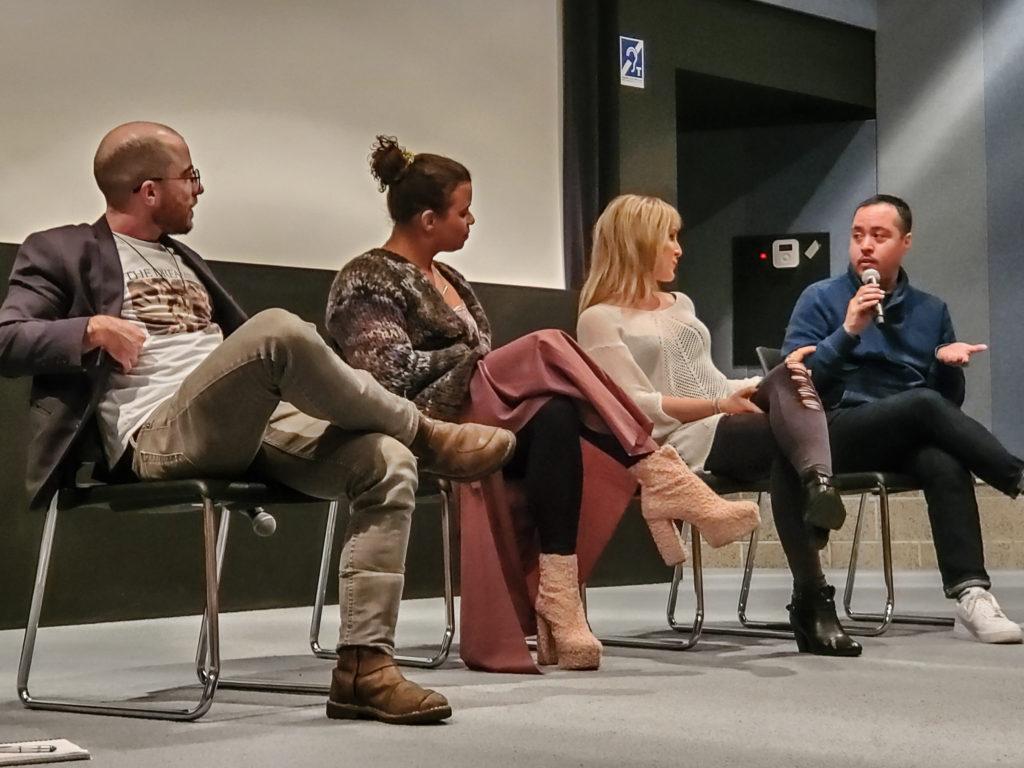
This semester, Grinnell students have had new opportunities to engage with trans film and media through visits from three prominent trans filmmakers to campus and a course taught by gender, women’s and sexuality studies professor AJ Lewis.
This past Tuesday, Grinnell welcomed trans filmmakers Chris Vargas, Zackary Drucker and Tourmaline to campus. At an event held in the Harris Center cinema, they each showed an audience of Grinnell students and staff one of their films. This screening was followed by a Q&A session with the audience.
The event was created as part of the curriculum for a unique “Trans Film and Media” class offered this semester. Professor AJ Lewis said that one of his goals in teaching the class is “to use popular media and popular representation as a lens through which to teach trans studies, simply because we’ve been in this conjuncture for the last several years in particular, where there’s just been … a proliferating sort of public discussion and visibility and representation around trans issues.” All three of the visiting filmmakers spoke similarly of having a goal of challenging mainstream conceptions of visibility.
The event itself started with a showing of Chris Vargas’ short film “Extraordinary Pregnancies.” The film is based on the story of Thomas Beatie, a trans man who, in 2007, captured the collective mind of the American public when he revealed himself to be pregnant. Vargas stars as Thomas Beatie on a faux-interview on cable television.
Throughout the course of the interview, he is asked increasingly personal and invasive questions, eventually being asked about his genitals and menstrual cycle. As such, Vargas’ character’s answers become ever more contemptuous. Eventually, he turns to the camera and breaks the fourth wall, telling the viewers directly that if they cannot accept him as a pregnant man then they need to reevaluate their conceptions of gender in society.
Nate Williams ’20, a student in the trans film and media class, praised Vargas’ “use of humor to convey explicit political messages.”
The next film played was Zackary Drucker’s “At Least You Know You Exist.” The film was shot on old film reels, giving it an antique look and feel. It opens with shots of an antiquated, cluttered apartment with a voiceover critiquing the constant capitalistic pursuit of material success.
During the Q&A session, Zackary explained that the apartment was once the gathering place of legendary drag queens. Dina, the main subject of the film, is then introduced as an old woman who succumbed to the pressure for financial success. She explains how she married an older, wealthy man and gave up her life for that.
Subsequently, a young woman, later revealed to be a young Dina, is shown stripping naked on a counter, ultimately revealing her penis to the audience. As the boogie-woogie background music grows in intensity, the older Dina frantically puts on make-up in an attempt to cling onto her youth.
Much of the rest of the film juxtaposes the old and young Dina, showing them posing in the same manner and eventually together. Fundamentally, the film toys with intergenerational patterns, messing with the passage of time and intertwining queer histories.
Finally, Tourmaline’s work-in-progress Many of Ill Fame was shown. The film opens in a prison during 1830s New York City and shows Mary Jones, a Black trans-woman, fleeing the building. During the Q&A session, Tourmaline explained that Mary Jones was a real Black trans woman who was arrested for stealing someone’s wallet in the 1830s.
The movie then cuts to her and her husband in their home in Seneca Village, a neighborhood that, as Tourmaline explained, had a thriving community of property-owning people of color before being demolished to build Central Park. A government official comes looking for Mary to try to take her back to prison. While her husband wants to negotiate and speak with the official, Mary advocates for dealing with the situation with witchcraft.
In a sequence that conflates reality and magic, as well as past, present and future, Mary casts a spell from her prison cell that incapacitates the officials. She finds herself fighting one of the officials in an open clearing before the film pans to the modern New York skyline and they look around bewildered at their time jump. Mary lies down in her prison cell in the 1800s, saying, “They’ll be back, but we’ll be ready.”
Much of Tourmaline’s work deals with the power of Black trans people, telling untold queer histories of people of color and shining a light on the power of a single Black trans woman who decides not to abide by society’s accepted behaviors.
During the Q&A, questions of visibility and representation were explicitly discussed. Drucker, having worked in mass-media representations of trans people through her work on the Emmy award-winning show Transparent, brought up that many of the most prominent and prevalent representations of trans people still come from portrayals by cisgender individuals. She and others questioned how accurate and authentic these representations can truly be.
Interestingly, as Williams put it, “In all of their work, they assume a trans audience, or at the very least, they assume an audience which is very acquainted with that world.”
He explained how this is different from conventional ideas of visibility in which a minority group reaches out to the majority and attempts to explain themselves. Instead, these trans filmmakers are making trans films for an explicitly trans audience.
Ultimately, all three filmmakers emphasized that trans visibility and politics are questions that all people, but especially trans people, must grapple with at one point. The landscape of visibility is constantly changing.
As Drucker so succinctly puts it, “I think the best part of being human is that we’re infinitely transformable.”



































































